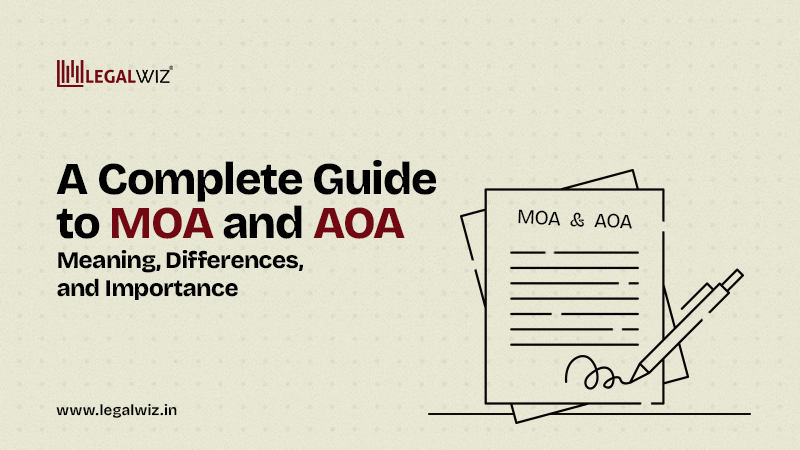A Complete Guide to MOA and AOA: Meaning, Differences, and Importance
Did you know that over 2 lakh companies are registered every year in India? While this number highlights the entrepreneurial spirit of the nation, it also underscores the importance of fulfilling legal requirements during incorporation. Among the key documents required for registering a company are the Memorandum of Association (MOA) and Articles of Association (AOA), the backbone of a company’s legal and operational framework.
A company must prepare these preliminary documents before applying for registration. The MOA and AOA must be submitted to the Registrar of Companies (ROC) along with the incorporation form. These documents are not mere formalities; they define the company’s scope of work, objectives, rules, and internal governance.
Often referred to as the company’s “constitution,” the MOA and AOA serve as the foundation for its existence and operations. They are indispensable, ensuring that the company remains aligned with its legal and operational boundaries while maintaining clarity in internal management. Founders must, therefore, draft these documents with absolute accuracy, precision, and clarity, as they directly impact the company’s smooth functioning and compliance.
With this understanding, let’s delve deeper into the significance, structure, and differences between MOA and AOA to help you navigate the intricacies of these essential legal documents.
What is MOA (Memorandum of Association)?
The Memorandum of Association (MOA) is a foundational legal document that defines a company’s objectives and scope of activities. It serves as the company’s charter, outlining the rules that govern its interaction with external entities, including shareholders, creditors, and regulatory bodies.
Key Features of MOA
- Defines Company Objectives and Promoters’ Holdings – Clearly states the purpose and intended activities of the business, along with details of the promoters and their initial shareholding.
- Boundary of Operations – Any action outside the defined scope is considered ultra vires (beyond legal power) and invalid.
- Mandatory for Company Registration – Every company, irrespective of its size, must have an MOA.
- Public Document – Available to stakeholders, ensuring transparency and compliance with regulatory authorities.
Contents of MOA
- Name Clause – Specifies the official name of the company, which must include “Limited” or “Private Limited.”
- Registered Office Clause – Mentions the state where the company is registered and operates.
- Object Clause – Defines the main and ancillary business activities the company is legally allowed to undertake.
- Liability Clause – Specifies the liability of shareholders, whether limited or unlimited.
- Capital Clause – Defines the type of securities issued by the company, such as Equity Shares, Preference Shares, or both.
- Subscription Clause – Lists the initial subscribers and the number of shares they hold, along with details of the professional verifying the document. It also includes the address, occupation, DIN (if applicable), and PAN details of all subscribers.
What is AOA (Articles of Association)?
The Articles of Association (AOA) is a governing document that outlines the internal rules and management structure of a company. It acts as a guide for company operations, ensuring efficient administration and governance.
Key Features of AOA
- Regulates Internal Affairs – Specifies the framework for corporate governance, including management roles, voting rights, and shareholder meetings.
- More Flexible than MOA – The AOA can be amended as per the company’s evolving needs.
- Mandatory for Private Companies – AOA is a mandatory document for all companies, whether Private or Public.
Contents of AOA
- Rules for Meetings – Outlines procedures for board meetings, general meetings, and shareholder resolutions.
- Director Roles and Powers – Defines the rights, responsibilities, and appointment process for directors.
- Shareholder Rights – Includes regulations on issuing shares, dividend policies, and voting rights.
- Conflict Resolution Mechanisms – Specifies dispute resolution frameworks for internal disagreements.
- Voting and Proxy Rules – Defines the rules for shareholders’ voting rights and the process for appointing proxies.
Difference between MOA vs. AOA
To better understand the distinction between the Memorandum of Association (MOA) and the Articles of Association (AOA), it’s essential to examine their key differences in detail. While both documents are integral to a company’s legal and operational framework, they serve distinct purposes and functions. The table below offers a comprehensive side-by-side comparison of MOA vs. AOA, highlighting their objectives, legal provisions, structure, and more.
| Points of Difference | Memorandum of Association (MOA) | Articles of Association (AOA) |
| Objective | Defines the relationship between the company, its shareholders, and third parties. | Focuses on defining the relationship between the company and its internal management. |
| Purpose | Contains foundational legal information, such as the company’s name, registered address, capital, liability, and primary business activity, available with the Registrar of Companies (ROC). | Includes rules, regulations, and procedures for the company’s internal governance. |
| Legal Provisions | Governed by Section 4 of the Companies Act, 2013. | Governed by Section 5 of the Companies Act, 2013. |
| Supremacy | The MOA is the supreme document of the company, drafted in accordance with the Companies Act. Other filings or documents cannot override its provisions. | Drafted in accordance with both the Companies Act, 2013, and the MOA. It cannot contradict the provisions of the Act or the MOA. |
| Structure & Content | Divided into six clauses: Name Clause, Registered Office Clause, Object Clause, Liability Clause, Capital Clause, and Subscription Clause. Each clause contains specific legal details about the company. | Organized into tabular formats based on the type of company (e.g., Table F for companies limited by shares). Each table is divided into articles detailing rules for internal operations. |
| Applicability | Mandatory for all types of companies and must be submitted to the ROC during incorporation. | Mandatory for all types of companies and must be submitted to the ROC during incorporation.. |
| Legal Scope | Defines the company’s external scope and objectives. Actions beyond its scope are considered ultra vires. | Governs internal processes, such as decision-making, shareholder rights, and operational rules. |
| Amendment Flexibility | Complex and require a few form filings and approval from MCA. | More flexible; Amendment is easy as compared to MoA due to less filings and approval process. |
| Public Accessibility | Acts as a public document, available to stakeholders and third parties. | Also a public document which can be accessed by stakeholders or third parties if required- directly from MCA portal |
Why Are MOA and AOA Important?
- Legal Compliance – Both documents are mandatory under the Companies Act and must be drafted correctly.
- Clarity on Business Objectives – The MOA ensures that the company’s purpose and operations are well-defined.
- Efficient Governance – The AOA lays the foundation for decision-making, management roles, and internal control.
- Stakeholder Confidence – Provides transparency and legal certainty to investors, shareholders, and regulators.
MOA vs. AOA: Ensuring Legal Clarity & Compliance
The difference between AOA and MOA lies in their core functions—MOA sets the business objectives and external framework, while AOA governs internal management and operational rules. Both documents are indispensable for company incorporation and regulatory compliance.
At LegalWiz, we provide expert legal drafting and advisory services to help businesses navigate the complexities of company formation.
Get Expert Assistance with MOA & AOA Drafting from LegalWiz
Drafting and understanding complex legal documents like MOA and AOA requires expert knowledge. LegalWiz offers professional services to make the process seamless:
- Professional Drafting: Our legal experts ensure your MOA and AOA are meticulously drafted, aligned with your business objectives and compliant with the Companies Act.
- Tailored Documentation: We tailor these documents to suit your unique business needs and type, whether you’re forming a Private Limited Company, OPC, Indian Subsidiary or Public limited company. Learn more about Company Registration in India here.
- End-to-End Support: From consultation on choosing the right business structure to managing compliance, we ensure a seamless registration process.
- Affordable Legal Solutions: At LegalWiz, we offer cost-effective legal solutions, making professional assistance accessible to businesses of all sizes.
Ready to streamline your company registration? Contact LegalWiz today!
Frequently Asked Questions
Who is responsible for signing the MOA and AOA?
The MOA and AOA are signed by the initial subscribers or shareholders of the company. These individuals are typically the promotersho agree to the terms and provisions outlined in these documents..
Who drafts the MOA and AOA?
The MOA and AOA are usually drafted by legal professionals, such as company secretaries or corporate lawyers, in consultation with the company’s founders. This ensures that the documents comply with legal standards and accurately reflect the company’s objectives and internal rules.
How can one access the MOA and AOA of a company?
Both the MOA and AOA are public documents and can be accessed through the Ministry of Corporate Affairs (MCA) portal. Anyone can obtain these documents by searching for the company’s details on the Registrar of Companies (ROC) records and paying the prescribed fees..

Amisha Shah
Amisha Shah heads content at LegalWiz.in, where she transforms complex legal concepts into clear, actionable insights. With extensive experience in legal, fintech, and business services, she helps startups and enterprises navigate regulatory challenges through engaging, accurate content that empowers informed business decisions.







